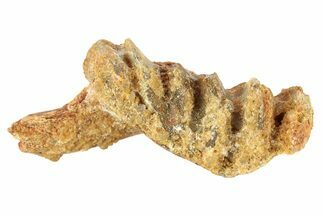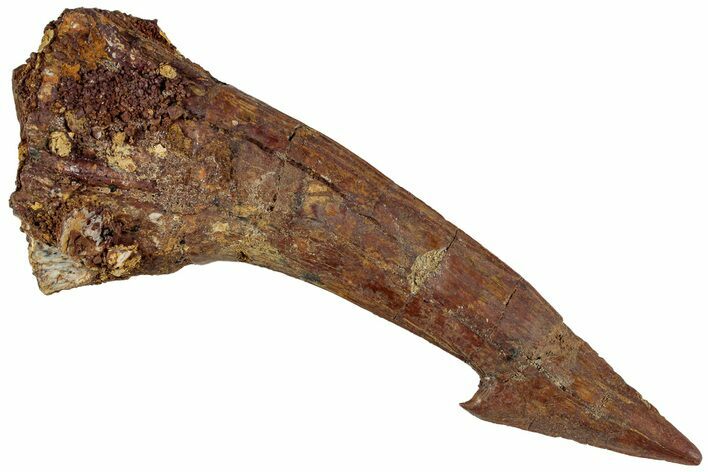This Specimen has been sold.
Huge, 3.9" Fossil Sawfish (Onchopristis) Rostral Barb - Morocco
This is a 3.9" long rostral barb/tooth from an extinct, giant sawfish (Onchopristis numidus). It was collected from the Kem Kem Beds in Taouz, Morocco. This large barb has some repaired cracks, though there is no significant gap fill restoration or any compositing.
About Onchopristis
Onchopristis, or “giant saw”, is a genus of extinct giant sawskate that lived during the Upper Cretaceous in what is now North Africa. It had a long, hard, shovel-shaped snout called a rostrum. The saw-like rostrum, lined on both sides with modified tooth-like structures with hooks and barbs called denticles. Onchopristis used its intimidating, 2-meter long rostrum to unearth crustaceans at the bottom of shallow waters like sawfish do today.
With the modern sawfish, the rostrum is covered with electrosensitive pores that allow the sawfish to detect slight movements of prey hiding in the muddy sea floor. The rostrum also serves as a digging tool. Should suitable prey try to swim past, the normally lethargic sawfish springs from the bottom and slashes at it with its saw. Sawfish also defend themselves with their rostrum against intruding predators such as sharks.
The bizarre-looking Onchopristis were frequently torn apart by Spinosaurus when this enormous ray traveled up freshwater streams to breed and lay eggs. Onchopristis probably lived in schools. Crocodiles, Spinosaurus and other fish-eating theropods would have feasted on the 8-meter long rays.
Onchopristis, or “giant saw”, is a genus of extinct giant sawskate that lived during the Upper Cretaceous in what is now North Africa. It had a long, hard, shovel-shaped snout called a rostrum. The saw-like rostrum, lined on both sides with modified tooth-like structures with hooks and barbs called denticles. Onchopristis used its intimidating, 2-meter long rostrum to unearth crustaceans at the bottom of shallow waters like sawfish do today.
With the modern sawfish, the rostrum is covered with electrosensitive pores that allow the sawfish to detect slight movements of prey hiding in the muddy sea floor. The rostrum also serves as a digging tool. Should suitable prey try to swim past, the normally lethargic sawfish springs from the bottom and slashes at it with its saw. Sawfish also defend themselves with their rostrum against intruding predators such as sharks.
The bizarre-looking Onchopristis were frequently torn apart by Spinosaurus when this enormous ray traveled up freshwater streams to breed and lay eggs. Onchopristis probably lived in schools. Crocodiles, Spinosaurus and other fish-eating theropods would have feasted on the 8-meter long rays.
The Kem Kem Group
The Kem Kem Group, also known as the Kem Kem Beds, is a significant geological formation located in southeastern Morocco, specifically in the region of the Anti-Atlas Mountains. This formation dates back to the late Cretaceous period, approximately 95 million years ago. The Kem Kem Beds are primarily composed of sandstone, siltstone, and claystone, interspersed with various sedimentary features that indicate a fluvial to deltaic environment.
The Kem Kem Group is renowned for its rich fossil deposits, which include a diverse array of prehistoric fauna. It has yielded a wide variety of dinosaur fossils, including theropods like Spinosaurus and Carcharodontosaurus, as well as large Sauropod dinosaurs such as Rebbachisaurus. Additionally, the beds are home to many other fossilized creatures, including crocodiles, pterosaurs, fish, and a range of invertebrates.
Paleontologists consider the Kem Kem Group an important site for studying late Cretaceous ecosystems and the evolution of vertebrate life. The fossils found in this region have provided valuable insights into the diversity and behavior of prehistoric species, making it a key location for both scientific research and fossil collecting. The striking landscapes of the Kem Kem Beds, with their colorful rock formations and dramatic geological features, also attract geologists and tourists interested in the natural history of the area.
A paper on this assemblage can be found at: Vertebrate assemblages from the early Late Cretaceous of southeastern Morocco: An overview
The Kem Kem Group, also known as the Kem Kem Beds, is a significant geological formation located in southeastern Morocco, specifically in the region of the Anti-Atlas Mountains. This formation dates back to the late Cretaceous period, approximately 95 million years ago. The Kem Kem Beds are primarily composed of sandstone, siltstone, and claystone, interspersed with various sedimentary features that indicate a fluvial to deltaic environment.
The Kem Kem Group is renowned for its rich fossil deposits, which include a diverse array of prehistoric fauna. It has yielded a wide variety of dinosaur fossils, including theropods like Spinosaurus and Carcharodontosaurus, as well as large Sauropod dinosaurs such as Rebbachisaurus. Additionally, the beds are home to many other fossilized creatures, including crocodiles, pterosaurs, fish, and a range of invertebrates.
Paleontologists consider the Kem Kem Group an important site for studying late Cretaceous ecosystems and the evolution of vertebrate life. The fossils found in this region have provided valuable insights into the diversity and behavior of prehistoric species, making it a key location for both scientific research and fossil collecting. The striking landscapes of the Kem Kem Beds, with their colorful rock formations and dramatic geological features, also attract geologists and tourists interested in the natural history of the area.
A paper on this assemblage can be found at: Vertebrate assemblages from the early Late Cretaceous of southeastern Morocco: An overview
SPECIES
Onchopristis numidus
LOCATION
Taouz, Kem Kem Basin, Morocco
FORMATION
Kem Kem Beds
SIZE
3.9" long
CATEGORY
SUB CATEGORY
ITEM
#230988
We guarantee the authenticity of all of our specimens.
 Reviews
Reviews














